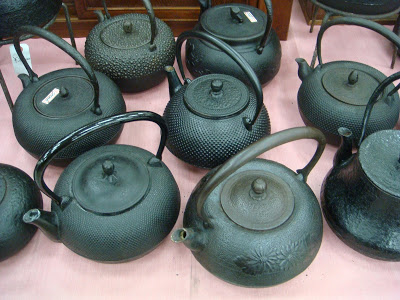 My friend Mary and I stepped it up from the local flea market to the Heiwajima Antique Fair this weekend in the Tokyo Ryutsu Center. It was very similar to the ever-intriguing Yamato Open Market, but with older stuff in better condition for higher prices. More variety too. There was the usual: kokeshi dolls, iron teapots, pottery, scrolls, Marilyn Monroe memorabilia, Star Wars figurines, tea bowls, etc.
My friend Mary and I stepped it up from the local flea market to the Heiwajima Antique Fair this weekend in the Tokyo Ryutsu Center. It was very similar to the ever-intriguing Yamato Open Market, but with older stuff in better condition for higher prices. More variety too. There was the usual: kokeshi dolls, iron teapots, pottery, scrolls, Marilyn Monroe memorabilia, Star Wars figurines, tea bowls, etc. 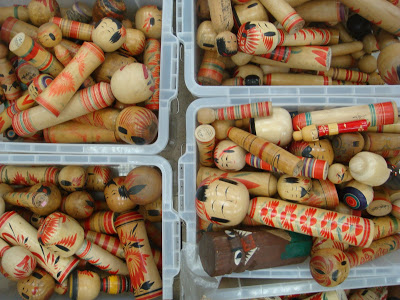 Then there was the unusual: entire suits of authentic samurai armor, gilded folding screens that cost more than our car, the severed stone head of what must have been an enormous Kannon, huge copper temple bells, and temple lanterns at the low low price of about $1,400 US (two-piece set-o).
Then there was the unusual: entire suits of authentic samurai armor, gilded folding screens that cost more than our car, the severed stone head of what must have been an enormous Kannon, huge copper temple bells, and temple lanterns at the low low price of about $1,400 US (two-piece set-o). 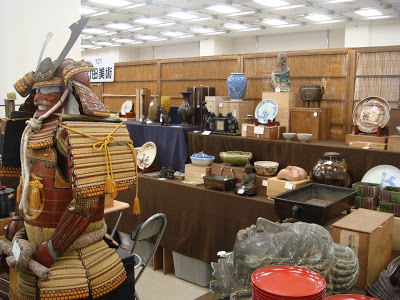 Then there were the truly unique world-wide treasures. One vendor had a spread of ancient Christian icons, rosaries and crucifixes. I wondered if they were Japanese dating to the brief window between when Western missionaries landed in Japan and when the nation closed to foreign influences and martyred all the Christians they could find. I asked where she got them. “They’re Russian,” the vendor said. “I went to Poland and many pieces were coming out of Russia.”
Then there were the truly unique world-wide treasures. One vendor had a spread of ancient Christian icons, rosaries and crucifixes. I wondered if they were Japanese dating to the brief window between when Western missionaries landed in Japan and when the nation closed to foreign influences and martyred all the Christians they could find. I asked where she got them. “They’re Russian,” the vendor said. “I went to Poland and many pieces were coming out of Russia.” 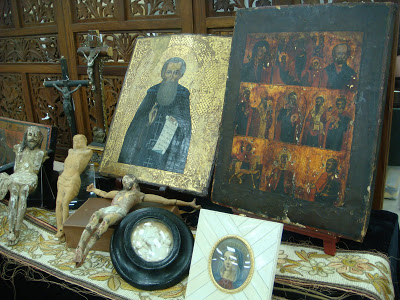 Russian was kind of a theme. I popped my head into one stall to get a closer look at an intricately carved ivory tusk and came face-to-face with the vendor, who asked me something unintelligible. I said, “Hmm?” and he said it again. I did my apologetically confused smile-shrug and he said, “Do you speak English?” I held up my fingers to show ‘a little’ halfway through his question because I thought he was asking if I spoke Japanese. “Where. Are. You. From?” he asked slowly. “The United States,” I answered. He spoke normally: “Then why do you only speak a little English?” I laughed. “Excuse me. I do speak English. Nihongo-ga sukoshi wakarimasu.” I understand a little Japanese. “Ah,” he said. “I thought you were Russian. My wife is Russian and you look like her.” “Oh…. Do you have a picture?” I asked. He got his iphone from under his booth and showed me a picture of himself next to a woman who really did look a lot like me except that she was in an elaborate belly dancing costume. This was getting weirder and weirder. I like to compliment people, but complimenting his wife who he’d just said I looked like seemed like an awkward roundabout compliment to myself, so I wasn’t sure what to say. I settled on, “Oh! Very nice!” She’s a belly dancing teacher, he explained, and they just returned from Moscow where she was teaching a conference. He’d planned to buy some Asian antiques from some Russian dealers there, but with the exchange rate now in Russia’s favor the shops asked him to supply them with Japanese antiques. He explained what some of the tiny carved ivory antiques in his display case were. As I left I said, “Spasibo!” (thank you in Russian) to try to make up for not understanding the only language I can speak. He smiled and said, “Ah! You’re welcome.”
Russian was kind of a theme. I popped my head into one stall to get a closer look at an intricately carved ivory tusk and came face-to-face with the vendor, who asked me something unintelligible. I said, “Hmm?” and he said it again. I did my apologetically confused smile-shrug and he said, “Do you speak English?” I held up my fingers to show ‘a little’ halfway through his question because I thought he was asking if I spoke Japanese. “Where. Are. You. From?” he asked slowly. “The United States,” I answered. He spoke normally: “Then why do you only speak a little English?” I laughed. “Excuse me. I do speak English. Nihongo-ga sukoshi wakarimasu.” I understand a little Japanese. “Ah,” he said. “I thought you were Russian. My wife is Russian and you look like her.” “Oh…. Do you have a picture?” I asked. He got his iphone from under his booth and showed me a picture of himself next to a woman who really did look a lot like me except that she was in an elaborate belly dancing costume. This was getting weirder and weirder. I like to compliment people, but complimenting his wife who he’d just said I looked like seemed like an awkward roundabout compliment to myself, so I wasn’t sure what to say. I settled on, “Oh! Very nice!” She’s a belly dancing teacher, he explained, and they just returned from Moscow where she was teaching a conference. He’d planned to buy some Asian antiques from some Russian dealers there, but with the exchange rate now in Russia’s favor the shops asked him to supply them with Japanese antiques. He explained what some of the tiny carved ivory antiques in his display case were. As I left I said, “Spasibo!” (thank you in Russian) to try to make up for not understanding the only language I can speak. He smiled and said, “Ah! You’re welcome.” 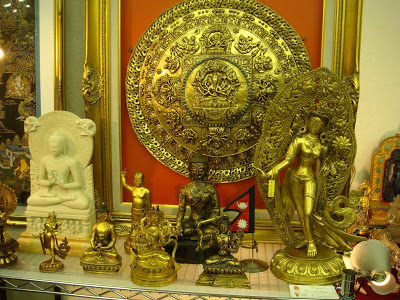 There were a couple vendors selling beautiful gem-encrusted tea pots, sea shells and Buddhist icons from Nepal. One Nepalese seller who learned English listening to Bryan Adams and watching American movies said he exports items his brother finds at home around Nepal. Emeralds, lapis and Indian rubies the size of my thumb drove prices on these treasures pretty high. Bummer—I wanted that teapot! The guy in the next booth showed me his antique, gold-plated Japanese incense boxes and sake cups. He too spoke excellent English and worked in the World Trade Center in New York for a decade until the year before the attack. I said, “Good timing. You are very lucky.” “Yes, but many people I worked with there were not,” he said, sort of ending the conversation.
There were a couple vendors selling beautiful gem-encrusted tea pots, sea shells and Buddhist icons from Nepal. One Nepalese seller who learned English listening to Bryan Adams and watching American movies said he exports items his brother finds at home around Nepal. Emeralds, lapis and Indian rubies the size of my thumb drove prices on these treasures pretty high. Bummer—I wanted that teapot! The guy in the next booth showed me his antique, gold-plated Japanese incense boxes and sake cups. He too spoke excellent English and worked in the World Trade Center in New York for a decade until the year before the attack. I said, “Good timing. You are very lucky.” “Yes, but many people I worked with there were not,” he said, sort of ending the conversation. 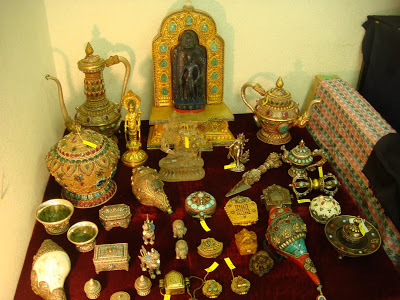 I was in the market for some temple lanterns, which I’ve seen in my go-to stuff book “Japanese Accents in Western Interiors.” But the cheapest ones I could find were more than $100 US for a small-ish set of two. Pass. I know Chris wants a Japanese flag and I found some from WWII with a Japanese soldier’s name on one side and “Fight bravely, return safely,” or something written across the top, all in kanji. The seller asked if I liked WWII. I wasn’t sure how to answer that tactfully so I said, “The flag feels sad and very brave. I like it very much.” She also had a senninbari—a silk cloth decorated with a thousand knots forming the character that means, “eternal good luck in war.” All the women who knew the boy going to war would contribute a knot to the cloth to signify their hopes for his safe return and he would tie it around his waist in battle for protection. Unfortunately I didn’t have enough money left for either, so I’ll have to find Chris another flag at another market. So in conclusion: the antique fair had many interesting things and—even better—many interesting, knowledgeable vendors!
I was in the market for some temple lanterns, which I’ve seen in my go-to stuff book “Japanese Accents in Western Interiors.” But the cheapest ones I could find were more than $100 US for a small-ish set of two. Pass. I know Chris wants a Japanese flag and I found some from WWII with a Japanese soldier’s name on one side and “Fight bravely, return safely,” or something written across the top, all in kanji. The seller asked if I liked WWII. I wasn’t sure how to answer that tactfully so I said, “The flag feels sad and very brave. I like it very much.” She also had a senninbari—a silk cloth decorated with a thousand knots forming the character that means, “eternal good luck in war.” All the women who knew the boy going to war would contribute a knot to the cloth to signify their hopes for his safe return and he would tie it around his waist in battle for protection. Unfortunately I didn’t have enough money left for either, so I’ll have to find Chris another flag at another market. So in conclusion: the antique fair had many interesting things and—even better—many interesting, knowledgeable vendors!
Where Globe-Trotting meets Beach-Combing

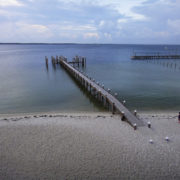 What’s Up in the Wing
What’s Up in the Wing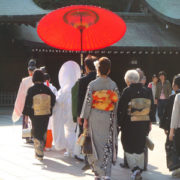 Omikuji—Poem-drawing at Meiji Shrine
Omikuji—Poem-drawing at Meiji Shrine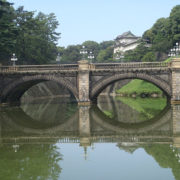 Just Another Day at the Palace
Just Another Day at the Palace Australia Sans-Photos
Australia Sans-Photos
That is my favorite place to go for antiques!!!! So glad you went!
Hahaha! Are you sure you are not Russian?!!